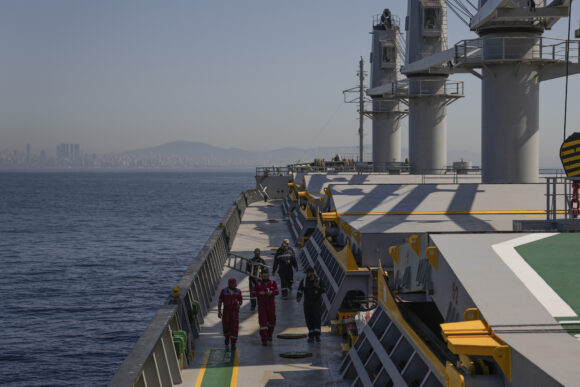Ukraine is scrambling to ship as much grain as it can this summer, taking advantage of military gains it has made in the Black Sea area to boost exports even as Russia has attacked its ports.
Ukraine is a major global wheat and corn grower and before Russia’s invasion in 2022 the country exported about 6 million tons of grain alone per month via the Black Sea.
Grain sales are a crucial revenue source and while global prices are weak, Ukraine’s cash-strapped farmers have little choice but to push ahead with exports because they need to fund the next winter sowing season.
Ukraine doubled food exports in July to over 4.2 million metric tons from the same month last year, according to data from Ukraine’s UGA traders’ union, despite intensified Russian attacks on Odesa, a key Black Sea export hub, and Izmail, a major port along the Danube River taking grain into Europe.
Ukraine has not yet reported the destinations of its exports in July, but last season it exported most of its wheat to Spain, Egypt and Indonesia, with its corn mostly heading for Spain and China.
The surge comes despite this season’s drop in output caused by war-related disruptions, and there is no guarantee that Kyiv can sustain the trend into the full 2024/25 season.
“We are doing everything to make business feel comfortable even in wartime conditions,” Dmytro Barinov, deputy head of Ukraine’s Seaport Authority, told Reuters.
The exports are a combination of new season wheat plus corn from stocks following last year’s bumper harvest.
So far, Ukraine has exported 3.7 million tons of agricultural goods in July through Odesa and 569,000 tons via the Danube, export data showed. That compared with 291,000 tons via Odesa and 2.07 million tons through the Danube in July 2023.
There were six shipments of corn from Ukraine’s other two operational Black Sea ports of Chornomorsk and Pivdennyi in June and July to Rotterdam, Europe’s busiest port, and Spain’s Cartegna, separate LSEG shipping data showed.
Since July, Ukraine has also shipped cargoes to China, Egypt and Turkey, separate data from Kpler showed.
Despite last month’s stronger sales, overall exports for the 2024/25 season are expected to fall because of unfavorable weather and the war’s impact, the ASAP agricultural consultancy said.
“We expect that grain exports from Ukraine could plunge by 14.5 million tons per year and touch almost a decade low of 35 million tons,” ASAP said.
Ports Targeted
Ukraine has managed to create a shipping corridor after a U.N.-backed Black Sea grain export initiative collapsed last year. Russia’s Black Sea Fleet has been forced to move nearly all its combat-ready warships from occupied Crimea to other locations.
While the improved security situation has lowered insurance and freight rates, making exports more competitive, Kyiv’s challenge is to ensure its ports that are accessible can ship out cargoes.
Ukraine has sustained multiple missile and drone attacks in recent weeks, some of which have targeted Odesa and Izmail.
Even as ships have so far avoided any major damage, Ukrainian officials say port infrastructure is being targeted.
“The Russians are well aware of that and they’re hitting the weak spots,” said Barinov with Ukraine’s Seaport Authority.
“They’re hitting with precision missiles, they’re deliberately destroying our ability to export, to process.”
Barinov and other shipping officials said Russia was avoiding strikes at the international sea lanes outside of Ukrainian port limits, keeping escalation contained.
Ukraine’s military assists ships entering and exiting ports, with captains operating under specific safety instructions, the country’s navy chief Vice-Admiral Oleksiy Neizhpapa told Reuters.
“Ukrainian air defense forces cover these corridors and ports. All assets, from air defense groups to missile systems along the coast, contribute to this effort,” Neizhpapa said.
Nonetheless, Ukraine has to cope with a multitude of other difficulties, including energy blackouts that disrupt port operations and exports.
Munro Anderson, head of operations at marine war risk and insurance specialist Vessel Protect, part of Pen Underwriting, said Russian strikes at targets inside Ukraine while less frequent than earlier in the war, continued to pressure Kyiv.
“Such attacks persist in applying pressure on the commercial maritime environment in Ukraine and thus achieve the Russian intent of eroding Ukrainian ability to fully capitalize on the potential output from these ports.”
Additional war risk premiums for ships entering Ukrainian ports have been quoted in recent months at up to 1.2% of the value of the ship with discounts that could mean a lower rate, insurance sources said. Those premiums spiked to as much as 3% in November after a missile strike damaged a ship in Pivdennyi.
This still works out at hundreds of thousands of dollars in additional estimated costs for a seven-day voyage and those costs could increase if security conditions deteriorated.
Industry sources said war underwriters were keeping the situation under review in the light of the recent attacks.
“Increased shelling of ships in corridor ports may prompt reinsurers to revise their war risks insurance rates,” said Maksym Dubovyi, managing partner with insurance broker Atria.
During its year of operation, Ukraine’s sea corridor has enabled 2,059 ships to deliver 57.7 million tons of cargoes to 46 countries, including 39 million tons of agricultural products, said Neil Roberts, head of marine and aviation at the Lloyd’s Market Association, which represents the interests of all underwriting businesses in the Lloyd’s of London insurance market.
“Individual underwriters will decide the rate as appropriate in the light of events and take their own view on the risk.”
(Reporting by Jonathan Saul and Tom Balmforth in London, Pavel Polityuk in Kyiv; editing by Tomasz Janowski)
Photograph: The cargo ship Med Island, which came from Ukraine loaded with grain, is seen here anchored in the Marmara Sea in Istanbul, Turkey, on Oct. 1, 2022. (AP Photo/Khalil Hamra, File)
Topics Russia
Was this article valuable?
Here are more articles you may enjoy.



 Florida Insurer Can’t Object to Appraiser After the Award Is Decided, 11th Circuit Says
Florida Insurer Can’t Object to Appraiser After the Award Is Decided, 11th Circuit Says  Hurricane Debby Brings Six Deaths, Widespread Flood Losses in Florida, Georgia, SC
Hurricane Debby Brings Six Deaths, Widespread Flood Losses in Florida, Georgia, SC  California Commissioner Orders Insurance Cancelation Moratorium for 185K Residents
California Commissioner Orders Insurance Cancelation Moratorium for 185K Residents  Insurer’s Lack of Repairs Caused Woman’s Death After Ian, Florida Lawsuit Says
Insurer’s Lack of Repairs Caused Woman’s Death After Ian, Florida Lawsuit Says 

